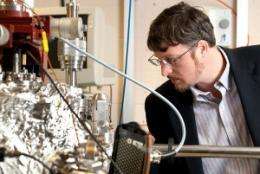Improving Semiconductor Technology

(PhysOrg.com) -- The ultimate goal of engineering professor Brian Willis' research is to improve the functionality of future electronic devices.
High-tech industries are always looking for ways to improve their products - trying to make things that are fast, faster; things that are low powered, lower powered; and things that are small, smaller. Many of these improvements are enabled by semiconductor technology. By continuously improving electronic device design and introducing new materials, new technologies are advancing extremely fast.
Chemical engineering professor Brian Willis hopes to promote the advance of electronic device technology through his research on the integration of oxide materials with the semiconductor industry standard, silicon.
Willis is an associate professor of chemical, materials, and biomolecular engineering and director of the Chemical Engineering Program. He joined UConn in 2008.
“For every application there is a material that is performing some function, and you can always improve that function and make it better at what it does,” he says. Willis received a National Science Foundation Early Career (CAREER) Development Award in 2003, with continued funding this year, for his project.
“Crystalline oxides will add new capabilities to future electronic devices,” he says.
Willis notes that the age of using silicon as the primary functional material in electronic devices has run its course. As semiconductor devices near the limits of miniaturization and speed, new ideas are necessary to add value. However, because silicon is so widely used and is the industry standard, he says, it is likely that silicon will remain as the platform or support material, and so the way to improve its functionality is to integrate it with another material.
Looking at oxides has allowed him to expand the functionality of semiconductor research. “Oxides have unique functional properties that would enable you to make interesting devices that you can’t make from silicon,” he says.
“Technologically, because silicon is such an established platform in nano-electronics, the most practical applied way forward is to somehow integrate the oxides with the silicon,” says Willis.
To do so, researchers must “go around Mother Nature to grow oxide materials atom by atom on top of a silicon wafer,” he says. But nature impedes this process because, when silicon is mixed with oxygen - an element needed to form oxides - it may inadvertently make silicon dioxide, experienced more widely as a major component of sand, and very stable.
“You have sort of a ‘Catch-22′ or a paradox,” says Willis. “You want to grow an oxide on top of silicon, but you have to avoid forming silicon dioxide.” That is where the real trick comes.
The process of layering silicon with oxide materials is relatively untapped, and there is good reason for this: oxides and silicon are very different materials, with widely different structural properties. To explain this concept, Willis turns to a memorable high school chemistry lesson: “like mixes with like,” and these materials are so unlike that integrating them is like trying to mix oil and water.
This dilemma is solved by the introduction of alkaline earth metals. Calcium, barium, and strontium have special properties that enable the oxides to be grown on the silicon without forming silicon dioxide. Essentially, they love oxygen more than silicon, and facilitate the integration of the oxides with the silicon substrate.
This layering using the alkaline earth metals has been done before in a laboratory setting, so it has been proven possible. What is lacking is any real-world analysis, Willis says. To make this a practical technology that could be integrated into everyday processes, the technique must have the potential for manufacture. This is the crux of his research, making the process both applicable in the real world and cost-effective.
With his graduate student and post-doctoral research assistants, Han Wang and Changbin Zhang, Willis has passed the first milestone in discovering the steps necessary for the integration of oxides and silicon. Now it may be only a matter of time before they are integrated in a way that can be manufactured and adopted by the industry.
The significance of this research is at the very core of the technology industry. If the integration is successful, it will “make devices better in the future,” says Willis, “so that you can have new functionalities 10 years from now that you wouldn’t be able to think of right now.”
Willis is also involved in educational initiatives. In the summer, he will host high school science teachers in his lab and teach them about basic characterization tools that are used in nanotechnology, so they can take the lessons they learn back to their classrooms.
Willis says the semiconductor industry is driven very strongly by new products and new ideas: “Companies like Intel are investing in new technologies that I originally thought were too far out, too academic, or too high risk. They’re doing it because nanotechnologies are the driving force for future projects.”
That’s why technology companies are so open to new ideas, even crazy and difficult new ideas, he adds: “If the industry doesn’t innovate, it will die.”
Provided by University of Connecticut

















